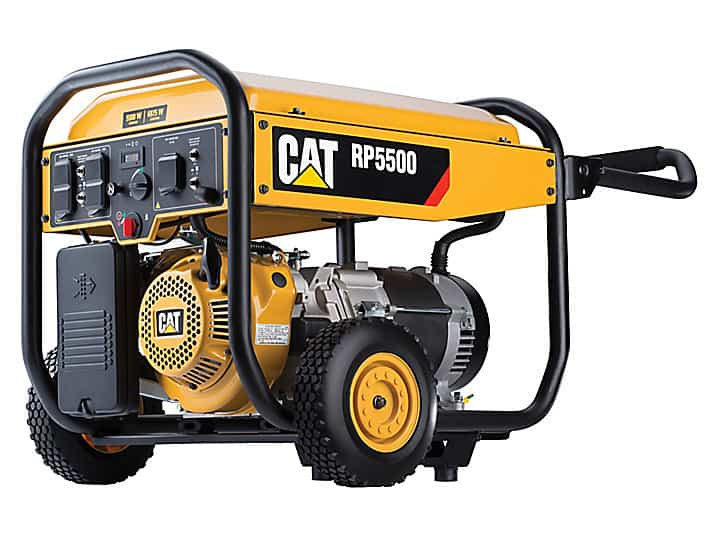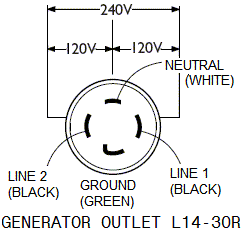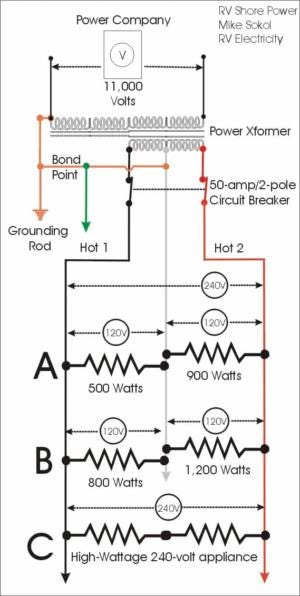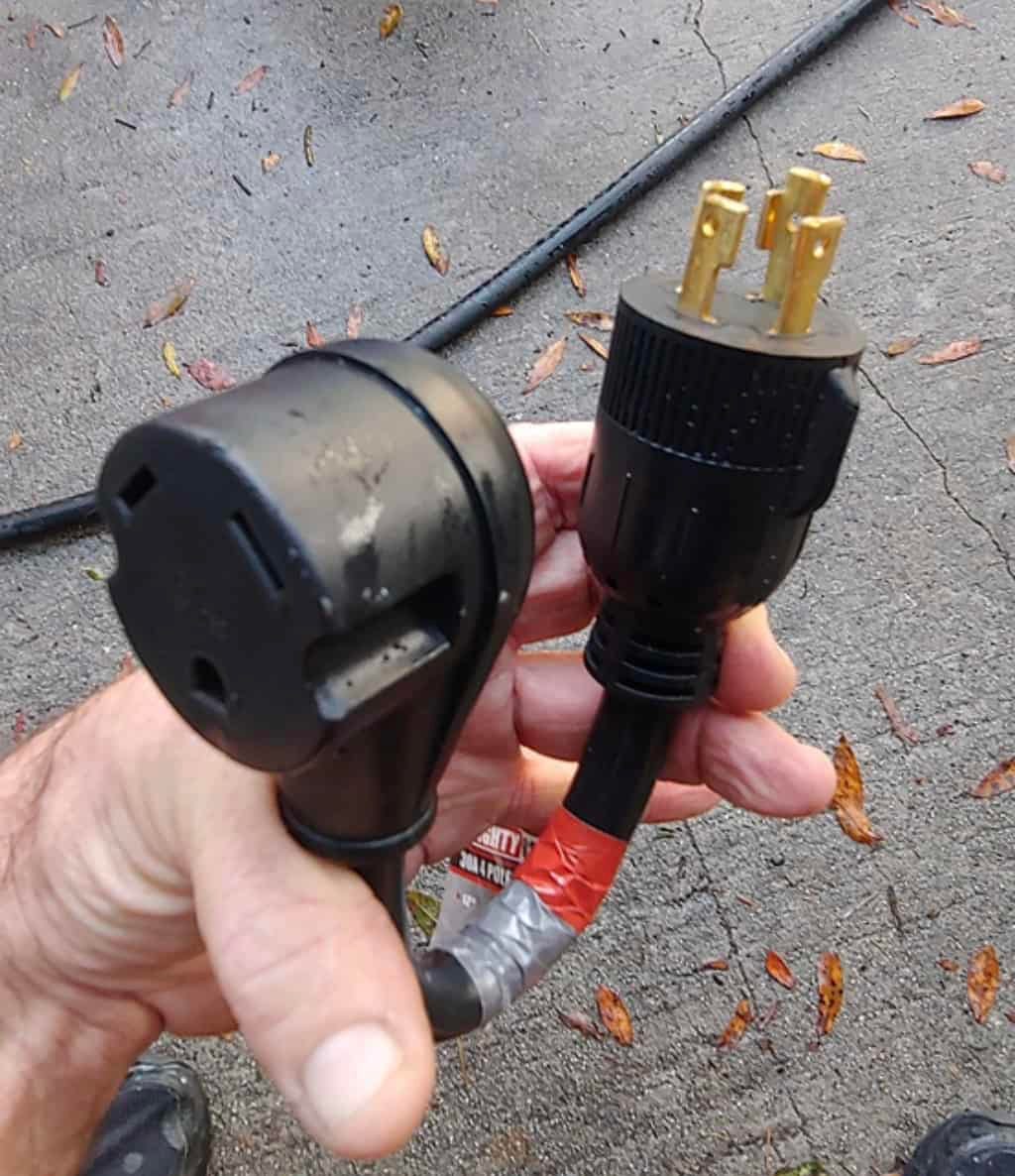Plugging your 120-volt RV into a 240-volt generator
It's easier than you think, but make sure the dogbone adapter is wired correctly
Dear Mike,
I am helping my brother with an issue where his Cat RP5500 generator trips a GFCI breaker on the generator when he plugs in his travel trailer. When he plugs the trailer into shore power (his home), it powers up and everything will run without issue. He is borrowing the Cat generator from a friend. The instant he plugs in his TT into a 120-volt 20-amp outlet the GFCI breaker trips on the generator.
We found your article “When A Portable Generator Won’t Power Your RV” and my brother made his own bonding plug, thinking the generator is not already bonded. It didn’t work. The moment he inserted the DIY bonding plug, the GFCI breaker tripped on the generator. He triple-checked the bonding plug to be assured that he connected the common to the ground and all looked good. Now I am thinking the Cat generator may be already bonded, as your video suggested that generators over 5000 watts are usually bonded.
We don’t think the trailer has any voltage protector system installed. The trailer is maybe 15+ years old and new to him and me. We don’t have any history on the trailer, but the electrical systems seem to be in good order. I am hoping you can provide us with some ideas on where to check next. We would greatly appreciate your suggestions. Regards, Joe
Dear Joe,
Per our phone call, here’s what I was able to ascertain. This particular generator is actually bonded at the factory, since that’s a requirement if it has a GFCI outlet. Therefore, any generator with a GFCI breaker on the 120-volt outlet is almost certainly bonded. So, there was no need for you to add a neutral bonding plug, and that would never help with GFCI nuisance tripping anyways.
Use the generator twist-lock outlet…
Your GFCI tripping is most likely due to additive leakage currents within your RV, which is expected and harmless. But there are also a few other issues that can be causing it, and I’ll post an article soon about a simple way to test for this.
Since RVs generally don’t play well with GFCI outlets, that is is why GFCI protection isn’t required on 30- and 50-amp pedestal outlets. So, I think the proper solution is for you to use the generator’s 4-prong, twist-lock, 120/240-volt receptacle with the proper dogbone adapter. It looks scary, doesn’t it?
But is it 120 or 240 volts?
This (as will most 5,000-watt and above) generator produces 120/240 volts Split-Phase power on a 4-prong, twist-lock outlet. That is exactly the same type of electrical power you’ll find in your residential service panel, as well as any 50-amp RV pedestal. So we can treat it like two separate 120-volt AC feeds.
Here’s a quick diagram I made that shows how split-phase power is wired from a campground pedestal into your RV’s electrical system. This is exactly how the entire U.S. power grid is wired, so there’s nothing special about it. Split-phase 120/240-volt power distribution has been around for at least 100 years.
What you need is a 4-prong male generator to 3-prong TT-30 outlet adapter. Instead of using both Hot 1 and Hot 2 to power your RV, this adapter will use the Neutral and Hot 1, plus carry the safety ground along, as well. As you can see from the diagram, connecting between Neutral and either Hot 1 or Hot 2 will provide 120 volts AC.
Caveat emptor…
However, I’ve see a few DIY (i.e., home-built) dogbone adapters that connected both Hot-1 and Hot-2 to the TT-30 female outlet. Those did send 240 volts in the RV’s 120-volt electrical system – which caused a lot of damage in seconds. But if you purchase a name-brand dogbone adapter from a reputable source, that should not be an issue.
So don’t use a dogbone adapter for this that your friendly neighborhood repair guy built for you. He may have the best intentions, but may not be knowledgable about RV electrical systems.
Since I’m paranoid (but am I paranoid enough?), I would still measure this after plugging it into the generator but before connecting my RV to it. Here’s a Camco dogbone adapter that I’ve personally tested and know is properly wired, which you can purchase at many big box stores or on Amazon HERE.
Dear Mike,
Getting back in touch with to let you know how things worked out. Your advice and recommendation was very helpful and solved our dilemma.
My brother purchased the four-prong generator adapter with the 30-amp RV end, shown in picture, and used this to connect his RV to the generator. It worked beautifully. Thank you for your help! It was greatly appreciated. Regards, Joe
OK, everyone. Remember that electricity is a useful and powerful force, so we all need to pay attention to safety precautions while using it.
Let’s play safe out there…. Mike
Some of the products above may have affiliate links. This means that, at zero cost to you, I will earn a commission if you click through the link and finalize a purchase.








